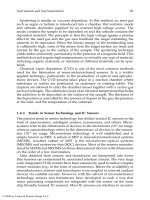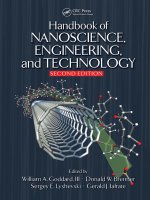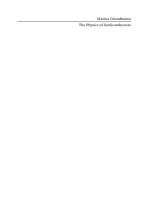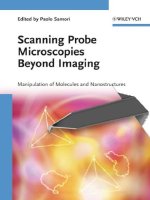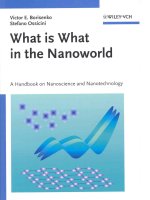- Trang chủ >>
- Khoa Học Tự Nhiên >>
- Vật lý
sensors, nanoscience, biomedical engineering and instruments, 2006, p.388
Bạn đang xem bản rút gọn của tài liệu. Xem và tải ngay bản đầy đủ của tài liệu tại đây (12.15 MB, 388 trang )
The Electrical Engineering Handbook
Third Edition
Sensors, Nanoscience,
Biomedical Engineering,
and Instruments
The Electrical Engineering Handbook Series
Series Editor
Richard C. Dorf
University of California, Davis
Titles Included in the Series
The Handbook of Ad Hoc Wireless Networks, Mohammad Ilyas
The Avionics Handbook, Cary R. Spitzer
The Biomedical Engineering Handbook, Third Edition, Joseph D. Bronzino
The Circuits and Filters Handbook, Second Edition, Wai-Kai Chen
The Communications Handbook, Second Edition, Jerry Gibson
The Computer Engineering Handbook, Vojin G. Oklobdzija
The Control Handbook, William S. Levine
The CRC Handbook of Engineering Tables, Richard C. Dorf
The Digital Signal Processing Handbook, Vijay K. Madisetti and Douglas Williams
The Electrical Engineering Handbook, Third Edition, Richard C. Dorf
The Electric Power Engineering Handbook, Leo L. Grigsby
The Electronics Handbook, Second Edition, Jerry C. Whitaker
The Engineering Handbook, Third Edition, Richard C. Dorf
The Handbook of Formulas and Tables for Signal Processing, Alexander D. Poularikas
The Handbook of Nanoscience, Engineering, and Technology, William A. Goddard, III,
Donald W. Brenner, Sergey E. Lyshevski, and Gerald J. Iafrate
The Handbook of Optical Communication Networks, Mohammad Ilyas and
Hussein T. Mouftah
The Industrial Electronics Handbook, J. David Irwin
The Measurement, Instrumentation, and Sensors Handbook, John G. Webster
The Mechanical Systems Design Handbook, Osita D.I. Nwokah and Yidirim Hurmuzlu
The Mechatronics Handbook, Robert H. Bishop
The Mobile Communications Handbook, Second Edition, Jerry D. Gibson
The Ocean Engineering Handbook, Ferial El-Hawary
The RF and Microwave Handbook, Mike Golio
The Technology Management Handbook, Richard C. Dorf
The Transforms and Applications Handbook, Second Edition, Alexander D. Poularikas
The VLSI Handbook, Wai-Kai Chen
The Electrical Engineering Handbook
Third Edition
Edited by
Richard C. Dorf
Circuits, Signals, and Speech and Image Processing
Electronics, Power Electronics, Optoelectronics,
Microwaves, Electromagnetics, and Radar
Sensors, Nanoscience, Biomedical Engineering,
and Instruments
Broadcasting and Optical Communication Technology
Computers, Software Engineering, and Digital Devices
Systems, Controls, Embedded Systems, Energy,
and Machines
The Electrical Engineering Handbook
Third Edition
Sensors, Nanoscience,
Biomedical Engineering,
and Instruments
Edited by
Richard C. Dorf
University of California
Davis, California, U.S.A.
A CRC title, part of the Taylor & Francis imprint, a member of the
Taylor & Francis Group, the academic division of T&F Informa plc.
Boca Raton London New York
Published in 2006 by
CRC Press
Taylor & Francis Group
6000 Broken Sound Parkway NW, Suite 300
Boca Raton, FL 33487-2742
© 2006 by Taylor & Francis Group, LLC
CRC Press is an imprint of Taylor & Francis Group
No claim to original U.S. Government works
Printed in the United States of America on acid-free paper
10987654321
International Standard Book Number-10: 0-8493-7346-8 (Hardcover)
International Standard Book Number-13: 978-0-8493-7346-6 (Hardcover)
Library of Congress Card Number 2005054343
This book contains information obtained from authentic and highly regarded sources. Reprinted material is quoted with
permission, and sources are indicated. A wide variety of references are listed. Reasonable efforts have been made to publish
reliable data and information, but the author and the publisher cannot assume responsibility for the validity of all materials
or for the consequences of their use.
No part of this book may be reprinted, reproduced, transmitted, or utilized in any form by any electronic, mechanical, or
other means, now known or hereafter invented, including photocopying, microfilming, and recording, or in any information
storage or retrieval system, without written permission from the publishers.
For permission to photocopy or use material electronically from this work, please access www.copyright.com
( or contact the Copyright Clearance Center, Inc. (CCC) 222 Rosewood Drive, Danvers, MA
01923, 978-750-8400. CCC is a not-for-profit organization that provides licenses and registration for a variety of users. For
organizations that have been granted a photocopy license by the CCC, a separate system of payment has been arranged.
Trademark Notice: Product or corporate names may be trademarks or registered trademarks, and are used only for
identification and explanation without intent to infringe.
Library of Congress Cataloging-in-Publication Data
Sensors, nanoscience, biomedical engineering and instruments / edited by Richard C. Dorf.
p. cm.
Includes bibliographical references and index.
ISBN 0-8493-7346-8 (alk. paper)
1. Biosensors. 2. Medical electronics. 3. Biomedical engineering. I. Dorf, Richard C. II. Title.
R857.B54S4555 2005
610.28 dc22 2005054343
Visit the Taylor & Francis Web site at
and the CRC Press Web site at
Taylor & Francis Group
is the Academic Division of Informa plc.
7346_Discl.fm Page 1 Thursday, November 17, 2005 3:27 PM
Preface
Purpose
The purpose of The Electrical Engineering Handbook, 3rd Edition is to provide areadyreferencefor the
practicing engineer in industry, government, and academia, as well as aid students of engineering.The third
edition has anew look and comprisessix volumes including:
Circuits, Signals, and Speech and Image Processing
Electronics, Power Electronics, Optoelectronics, Microwaves, Electromagnetics, and Radar
Sensors, Nanoscience, Biomedical Engineering, and Instruments
Broadcasting and Optical Communication Technology
Computers, Software Engineering, and Digital Devices
Systems, Controls, Embedded Systems, Energy, and Machines
Each volume is edited by Richard C. Dorf, and is acomprehensive format that encompasses the many
aspects of electrical engineering with articles from internationally recognized contributors. The goal is to
provide the most up-to-date information in the classical fields of circuits, signal processing, electronics,
electromagnetic fields, energydevices, systems, and electrical effects and devices, while covering the emerging
fields of communications, nanotechnology, biometrics, digital devices, computer engineering, systems, and
biomedical engineering.Inaddition, acomplete compendium of information regarding physical, chemical,
and materials data, as well as widely inclusiveinformation on mathematics is included in each volume. Many
articles from this volume and the other five volumes havebeen completely revised or updated to fit the needs
of today and manynew chapters havebeen added.
The purpose of this volume ( Sensors, Nanoscience, Biomedical Engineering, and Instruments) is to provide a
ready referencetosubjects in the fields of sensors, materials and nanoscience, instruments and measurements,
and biomedical systems and devices. Hereweprovide the basic information for understanding these fields. We
also provide information about the emerging fields of sensors, nanotechnologies, and biological effects.
Organization
The information is organized into three sections. The first twosections encompass 10 chapters and the last
section summarizes the applicable mathematics, symbols, and physical constants.
Most articles include three importantand useful categories: defining terms, references, and further
information. Defining terms are key definitions and the first occurrenceofeach term defined is indicated in
boldface in the text. The definitions of these terms are summarized as alist at the end of each chapter or
article. The references provide alist of useful books and articles for follow-up reading.Finally, further
information provides some general and useful sources of additional information on the topic.
Locating Your Topic
Numerous avenues of access to information are provided. Acomplete table of contents is presented at the
front of the book. In addition, an individual table of contents precedes each section. Finally,each chapter
begins with its own table of contents. The reader should look over these tables of contents to become familiar
with the structure, organization, and content of the book. For example, see Section II: Biomedical Systems,
then Chapter 7: Bioelectricity,and then Chapter 7.2: Bioelectric Events. This tree-and-branch table of contents
enables the reader to moveupthe tree to locate information on the topic of interest.
Twoindexes havebeen compiledtoprovide multiple means of accessing information: subject index and
index of contributing authors. The subject index can also be used to locate keydefinitions. The page on which
the definition appears for each key (defining) term is clearly identified in the subject index.
The Electrical Engineering Handbook, 3rd Edition is designed to provide answers to most inquiries and direct
the inquirer to further sources and references. We hope that this handbook will be referred to often and that
informational requirements will be satisfied effectively.
Acknowledgments
This handbook is testimonytothe dedication of the Board of Advisors, the publishers, and my editorial
associates. Iparticularly wish to acknowledge at Taylor &Francis Nora Konopka, Publisher;Helena Redshaw,
Editorial Project Development Manager ;and Susan Fox, Project Editor.Finally,Iam indebted to the
supportofElizabeth Spangenberger,Editorial Assistant.
Richard C. Dorf
Editor-in-Chief
Editor-in-Chief
Richard C. Dorf, Professor of Electrical and Computer Engineering at the UniversityofCalifornia, Davis,
teaches graduate and undergraduate courses in electrical engineering in the fields of circuitsand control
systems. He earned aPh.D.inelectrical engineering from the U.S. Naval Postgraduate School, an M.S. from
the University of Colorado,and aB.S. from Clarkson University. Highly concerned with the discipline of
electrical engineering and its wide value to social and economic needs, he has written and lectured
internationally on the contributions and advances in electrical engineering.
Professor Dorf has extensiveexperience with education and industryand is professionally active in the fields
of robotics, automation, electric circuits, and communications. He has serve dasavisiting professor at the
UniversityofEdinburgh, Scotland; the Massachusetts Institute of Technology; Stanford University; and the
UniversityofCalifornia, Berkeley.
Professor Dorf is aFellowofThe Institute of Electrical and Electronics Engineers and aFellow of the
American Societyfor Engineering Education. Dr.Dorf is widely known to the profession for his Modern
Control Systems, 10th Edition (Addison-Wesley,2004) and The International Encyclopedia of Robotics (Wiley,
1988). Dr.Dorf is also the co-author of Circuits, Devices and Systems (with Ralph Smith), 5th Edition (Wiley,
1992), and ElectricCircuits, 7th Edition (Wiley,2006). He is also the author of TechnologyVentures (McGraw-
Hill, 2005) and The Engineering Handbook, 2nd Edition (CRCPress, 2005).
AdvisoryBoard
Frank Barnes
UniversityofColorado
Boulder,Colorado
Joseph Bronzino
TrinityCollege
Hartford, Connecticut
Wai-Kai Chen
UniversityofIllinois
Chicago,Illinois
Delores Etter
United States Naval Academy
Annapolis, Mar yland
Lyle Feisel
State UniversityofNew York
Binghamton, NewYork
William Kersting
NewMexicoState University
Las Cruces,New Mexico
Vojin Oklobdzia
UniversityofCalifornia, Davis
Davis, California
John V. Oldfield
Syracuse University
Syracuse, NewYork
Banmali Rawat
UniversityofNevada
Reno,Nevada
Richard S. Sandige
California Polytechnic
State University
San Luis Obispo,California
Leonard Shaw
Polytechnic University
Brooklyn, NewYork
John W. Steadman
UniversityofSouth Alabama
Mobile, Alabama
R. Lal Tummala
Michigan State University
East Lansing,Michigan
Contributors
Ronald Arif
LehighUniversity
Bethlehem, Pennsylvania
Frank Barnes
University of Colorado
Boulder,Colorado
R.C. Barr
Duke University
Durham, NorthCarolina
Edward J. Berbari
Indiana University/Purdue University
Indianapolis, Indiana
RobertA.Bond
MIT LincolnLaboratory
Lexington, Massachusetts
Joseph D. Bronzino
TrinityCollege
Hartford, Connecticut
B.S. Dhillon
University of Ottawa
Ottawa, Ontario,Canada
Alan D. Dorval II
Boston University
Boston, Massachusetts
Halit Eren
Curtin University of Technology
Bentley,Western Australia, Australia
Martin D. Fox
University of Connecticut
Storrs, Connecticut
L.A. Geddes
Purdue University
Lafayette, Indiana
Victor Giurgiutiu
University of South Carolina
Columbia, South Carolina
DavidL.Hall
The Pennsylvania State
University
University Park, Pennsylvania
BryanStewart Hobbs
CityTechnologyLimited
Portsmouth, England
Zhian Jin
LehighUniversity
Bethlehem, Pennsylvania
Sam S. Khalilieh
Tyco Infrastructure Services
Grand Rapids, Michigan
James Llinas
State University of NewYork
at Buffalo
Williamsville, NewYork
Sergey Edward Lyshevski
Rochester Institute of Technology
Rochester,New Yo rk
DavidR.Martinez
MIT Lincoln Laboratory
Lexington, Massachusetts
M. Meyyappan
NASA Ames Research Center
Moffett Field, California
MichaelR.Neuman
Michigan Technological
University
Houghton, Michigan
John Pelesko
University of Delaware
Newark, Delaware
Yuan Pu
University of California
Irvine, California
ChristopherG.Relf
National Instruments Certified
LabVIEW Developer
NewSouth Wales, Australia
Bonnie Keillor Slaten
University of Colorado
Boulder,Colorado
RosemaryL.Smith
University of Maine
Orono,Maine
Ronald J. Tallarida
Temple University
Philadelphia, Pennsylvania
Nelson Tansu
LehighUniversity
Bethlehem, Pennsylvania
Charles W. Therrien
Naval Postgraduate School
Monterey,California
M. MichaelVai
MIT Lincoln Laboratory
Lexington, Massachusetts
Joseph Watson
University of Wales
Swansea, United Kingdom
John A. White
Boston University
Boston, Massachusetts
David Young
Rockwell Semiconductor Systems
NewportBeach, California
Contents
SECTION ISensors, Nanoscience, and Instruments
1 Sensors
1.1 Introduction RosemaryL.Smith 1-1
1.2 Electrochemical Sensors Bryan Stewart Hobbs 1-11
1.3 The Stannic Oxide Semiconductor Gas Sensor Joseph Watson 1-18
2 An Introduction to Multi-Sensor Data Fusion DavidL.Halland James Llinas 2-1
3 Magneto-optics David Young and Yuan Pu 3-1
4 Materials and Nanoscience
4.1 Carbon Nanotubes M. Meyyappan 4-1
4.2 Modeling MEMS and NEMS John Pelesko 4-9
4.3 Micromechatronics Victor Giurgiutiu and SergeyEdward Lyshevski 4-20
4.4 Nanocomputers, Nano-Architectronics, and Nano-ICs SergeyEdward Lyshevski 4-42
4.5 Semiconductor Nano-Electronics and Nano-Optoelectronics Nelson Tansu,
Ronald Arif, and Zhian Jin 4-68
5 Instruments and Measurements
5.1 Electrical Equipment in Hazardous Areas Sam S. Khalilieh 5-1
5.2 Portable Instruments and Systems Halit Eren 5-27
5.3 G(LabVIEW
TM
)SoftwareEngineering Christopher G. Relf 5-36
6 ReliabilityEngineering B.S. Dhillon 6-1
SECTION II Biomedical Systems
7 Bioelectricity
7.1 Neuroelectric Principles John A. White and Alan D. Dorval II 7-1
7.2 Bioelectric Even ts L.A. Geddes (revised by R.C. Barr) 7-13
7.3 Biological Effects and Electromagnetic Fields Bonnie Keillor Slaten and
Frank Barnes 7-33
7.4 Embedded Signal Processing DavidR.Martinez, Robert A. Bond, and M. Michael Vai 7-55
8 Biomedical Sensors Michael R. Neuman 8-1
9 Bioelectronics and Instruments
9.1 The Electro-encephalogram Joseph D. Bronzino 9-1
9.2 The Electrocardiograph Edward J. Berbari 9-14
10 Tomography Martin D. Fox 10-1
SECTION III Mathematics, Symbols, and Physical Constants
Introduction Ronald J. Ta llarida III-1
Greek Alphabet III-3
International System of Units (SI) III-3
Conversion Constants and Multipliers III-6
Physical Constants III-8
Symbols and Terminologyfor Physical and Chemical Quantities III-9
Credits III-13
Probabilityfor Electrical and Computer Engineers Charles W. Therrien III-14
Indexes
Author Index A-1
Subject Index S-1
I
Sensors, Nanoscience,
and Instruments
1Sensors R.L. Smith, B.S. Hobbs, J. Watson 1-1
Introduction
*
Electrochemical Sensors
*
The Stannic Oxide Semiconductor Gas Sensor
2AnIntroduction to Multi-Sensor Data Fusion D.L. Hall, J. Llinas 2-1
Introduction
*
Data Fusion Techniques
*
Applications of Data Fusion
*
Process Models
for Data Fusion
*
Limitations of Data Fusion Systems
*
Summary
3Magneto-optics D. Young, Y. Pu 3-1
Introduction
*
Classification of Magneto-optic Effects
*
Applications of Magneto-optic Effects
4Materials and Nanoscience M. Meyyappan, J. Pelesko,V.Giurgiutiu,
S.E. Lyshevski, N. Tansu, R. Arif, Z. Jin 4-1
Carbon Nanotubes
*
Modeling MEMS and NEMS
*
Micromechatronics
*
Nanocomputers,
Nano-Architectronics, and Nano-ICs
*
Semiconductor Nano-Electronics
and Nano-Optoelectronics
5Instruments and Measurements S.S. Khalilieh, H. Eren, C.G. Relf 5-1
Electrical Equipment in Hazardous Areas
*
Portable Instruments and Systems
*
G(LabVIEW
TM
)Software Engineering
6Reliability Engineering B.S. Dhillon 6-1
Introduction
*
Terms and Definitions
*
Bathtub Hazard-Rate Concept
*
Important Formulas
*
ReliabilityNetworks
*
Reliabilit yEvaluation Methods
*
Human Reliability
*
Robot Reliability
I -1
1
Sensors
RosemaryL.Smith
University of Maine
Bryan Stewart Hobbs
City Technology Limited
Joseph Watson
University of Wales
1.1 Introduction 1 -1
Physical Sensors
*
Chemical Sensors
*
Biosensors
*
Microsensors
1.2 Electrochemical Sensors 1 -11
Introduction
*
Potentiometric Sensors
*
Amperometric Sensors
1.3 The Stannic Oxide Semiconductor Gas Sensor 1 -18
Introduction
*
Basic Electrical Parameters and Operation
*
Operating Te mperature
*
Substrate Materials
*
Electrical Operating
Parameters
*
FutureDevelopments
1.1 Introduction
Rosemary L. Smith
Sensors are critical componentsinall measurementand control systems. The need for sensors that generate an
electronic signal closely followed the advent of the microprocessor and computers. Together withthe ever-
present need for sensors in science and medicine, the demand for sensors in automated manufacturing and
environmentalmonitoring is rapidly growing.Inaddition, small, inexpensive sensors are finding their way
into all sorts of consumer products, from children’s toys to dishwashers to automobiles. Because of the vast
varietyofuseful things to be sensed and sensor applications, sensor engineering is amultidisciplinaryand
interdisciplinaryfield of endeavor.This chapter introduces some basic definitions, concepts, and features of
sensors, and illustrates them with several examples. The reader is directed to the references and the sources
listed under Further Information for more details and examples.
There are manyterms which are often used synonymously for sensor,including transducer,meter,detector,
and gage. Defining the term sensor is not an easy task; however,the most widely used definition is that which has
been applied to electrical transducers by the Instrument SocietyofAmerica (ANSI MC6.1, 1975): ‘‘Transducer—
Adevice which provides ausable output in response to aspecified measurand.’’ Atransducer is more generally
defined as adevice which convertsenergyfrom one form to another.Usable output can be an optical, electrical,
chemical, or mechanical signal. In the context of electrical engineering,however,ausable output is usually an
electrical signal. The measurand is aphysical, chemical, or biological property or condition to be measured.
Most but not all sensors are transducers, employing one or moretransduction mechanisms to producean
electrical output signal. Sometimes sensors are classified as direct or indirect sensors, according to how many
transduction mechanisms are used. Forexample, amercurythermometer produces achange in volume of
mercuryinresponse to atemperature change viathermal expansion. The output signal is the change in height
of the mercurycolumn. Here, thermal energyisconverted into mechanical movement and we read the change
in mercuryheight using our eyes as asecond transducing element. However,inorder to use the thermometer
output in acontrol circuit or to log temperature data in acomputer,the height of the mercurycolumnmust
first be converted into an electrical signal. This can be accomplished by several means, but thereare more
direct temperature sensing methods, i.e., whereanelectrical output is produced in response to achange in
temperature. An example is given in the next section on physical sensors. Figure1.1 depicts asensor block
1 -1
diagram, indicating the measurand and associated input signal, the primaryand intermediate transduction
mechanisms, and the electronicoutput signal. Some transducers are auto-generators or active,whereausable
output signal, often electronic, is created directly in response to the measurand. However,manyother types of
transducers are modulators or passive,whereanauxiliaryenergysourceisused to transform the generated
response to an electronicoutput signal. Forexample, the piezoresistor is apassive sensor.Itisaresistor that
changes its resistance value when it is mechanically deformed or strained. In order to measure this change, it is
necessarytoattach avoltage or current source. Table 1.1 is asix-by-six matrix of some of the morecommonly
employed physical and chemical transduction mechanisms for sensing.Manyofthe effects listed are described
in moredetail elsewhereinthis handbook.
Today,sensorsare mostoften classified by the type of measurand, i.e., physical, chemical, or biological. This is a
much simpler means of classification than by transduction mechanism or output signal (e.g., digital or analog),
sincemanysensors use multiple transduction mechanisms and the output signal can always be processed,
conditioned, or converted by acircuit so as to cloud the definition of output. Adescription of each class and
examples are given in the following sections. The last section introduces microsensors and some examples.
In choosing aparticular sensor for agiven application, there are manyfactors to be considered. These
factors or specifications can be divided into three major categories: environmental factors, economic factors,
and sensor characteristics. The most commonly encountered factors are listed in Table 1.2, althoughnot all of
them may be pertinent to aparticular application. Most of the environmental factors determine the packaging
of the sensor,meaning the encapsulation and insulation required to protect or isolate components from the
environment, the input/output leads, connectors, and cabling.The economic factors determine the
manufacturing method and type of materials used to makethe sensor and to some extent the qualityofthe
materials. Forexample, averyexpensive sensor maybecosteffective if it is used repeatedly or for very long
periods of time. However,adisposable sensor like that used for early pregnancy testing should be inexpensive
and may only need to function accurately for afew minutes. The sensor characteristics of the sensor are
usually the specifications of primaryconcern. The most importantparameters are sensitivity, stability, and
repeatability. Normally,asensor is only useful if all three of these parameters are tightly specified for agiven
range of measurand values and time of operation. Forexample, ahighly sensitive device is not useful if its
output signal drifts greatly during the measurement time and the data obtained maynot be reliable if the
measurement is not repeatable. Other sensor characteristics, such as selectivityand linearity, can often be
compensated for by using additional, independent sensors or by signal conditioning circuits. Forexample,
most sensors will respond to temperature in addition to their primarymeasurand, since most transduction
mechanisms are temperature dependent. Therefore, temperature compensation is usually required if the
sensor is to be used in an environment wheretemperature is not controlled.
Physical Sensors
Physical measurands include temperature, strain, force, pressure, displacement, position, velocity,acceleration,
optical radiation, sound, flowrate, viscosity,and electromagnetic fields. Referring to Table 1.1, all but those
Primary
Transduction
Measurand
Input
Output
Signal
Intermediate
Transduction
Power
FIGURE 1.1 Sensor block diagram. Many sensors employ multiple transduction mechanisms in order to producean
electronic output in response to the measurand. Passivetransduction mechanisms requireinput power in order to produce
ausable output signal.
1 -2 Sensors, Nanoscience, Biomedical Engineering, and Instruments
TABLE 1.1 Physical and Chemical Transduction Principles
SecondarySignal
PrimarySignal Mechanical Thermal Electrical Magnetic Radiant Chemical
Mechanical (Fluid) mechanical and
acoustic effects
(e.g., diaphragm,gravity
balance, echo sounder)
Frictioneffects
(e.g., frictioncalorimeter)
Coolingeffects
(e.g., thermal flowmeters)
Piezoelectricity
Piezoresistivity
Resistive, capacitive,
and inductiveeffects
Magneto-mechanical
effects (e.g., piezo-
magnetic effect)
Photoelastic systems
(stress-induced
birefringence)
Interferometers
Sagnac effect
Doppler effect
—
Thermal Thermal expansion
(bimetal strip,liquid-in-
glass and gas
thermometers,
resonantfrequency)
Radiometer effect
(light mill)
—Seebeckeffect
Thermoresistance
Pyroelectricity
Thermal (Johnson) noise
—Thermo-optical effects
(e.g., liquid crystals)
Radiant emission
Reaction activation
(e.g., thermal
dissociation)
Electrical Electrokinetic and electro-
mechanicaleffects
(e.g., piezoelectricity,
electro-meter,
Ampere’slaw)
Joule (resistive) heating
Peltier effect
Chargecollectors
Langmuir probe
Biot–Savart’slaw Electro-optical effects
(e.g., Kerr effect)
Pockel’seffect
Electroluminescence
Electrolysis
Electromigration
Magnetic Magnetomechanical
effects
(e.g., magnetorestriction,
magnetometer)
Thermomagnetic effects
(e.g., Righi–Leduc effect)
Galvanomagnetic effects
(e.g., Ettingshausen effect)
Thermomagnetic effects
(e.g., Ettingshausen–
Nernst effect)
Galvanomagnetic effects
(e.g., Hall effect,
magnetoresistance)
—Magneto-optical effects
(e.g., Faradayeffect)
Cotton–Mouton effect
—
Radiant Radiation pressureBolometer thermopilePhotoelectric effects
(e.g., photovoltaic effect,
photoconductiveeffect)
—Photorefractiveeffects
Optical bistability
Photosynthesis,
dissociation
Chemical Hygrometer
Electrodeposition cell
Photoacoustic effect
Calorimeter
Thermal conductivity cell
Potentiometry
Conductiometry
Amperometry
Flameionization
Volta effect
Gas-sensitive
field effect
Nuclear magnetic
resonance
(Emission and absorption)
spectroscopy
Chemiluminiscence
—
Source:T.Grandkeand J. Hesse, Introduction, Vol. 1: Fundamentals and General Aspects, Sensors: AComprehensive Survey,W.Gopel, J. Hesse, and J.H. Zemel, Eds., Weinheim, Germany:
VCH, 1989. With permission.
1 -3Sensors
transduction mechanisms listed in the chemical columnare used in the design of physical sensors. Clearly,
they comprise averylarge proportion of all sensors. It is impossible to illustrate all of them, but three
measurands stand out in terms of their widespread application: temperature, displacement (or associated
force), and optical radiation.
Temperature Sensors
Temperatureisanimportant parameter in manycontrol systems, most familiarly in environmental control
systems. Several distinctly different transduction mechanisms havebeen employed to measure temperature.
The mercurythermometer was mentioned in the Introduction as atemperaturesensor which produced a
nonelectronic output signal. The most commonly used electrical signal generating temperature sensors are
thermocouples, thermistors, and resistance thermometers. Thermocouples employ the Seebeck effect, which
occurs at the junction of twodissimilar conductors. Avoltage difference is generated between the hot and cold
ends of the two conductors due to the differences in the energydistribution of electrons at the two
temperatures. The voltage magnitude generated depends on the properties of the conductor,e.g., conductivity
and work function, such that adifferencevoltage will be measured between the coolends of two different
conductors. The voltage changes fairly linearly with temperatureoveragiven range, depending on the choice
of conductors. To minimize measurement error,the cool end of the couple must be kept at aconstant
temperatureand the voltmetermust haveahighinput impedance. Acommonly used thermocouple is made
of copper and constantan wires. Athermocouple is an ‘‘auto-generator,’’i.e., it produces ausable output
signal, in this case electronic, directly in response to the measurand without the need for auxiliarypower.
The resistance thermometer relies on the increase in resistance of ametal wire with increasing temperature.
As the electrons in the metal gain thermal energy, they move about morerapidly and undergo morefrequent
collisions with each other and the atomic nuclei. These scattering events reduce the mobilityofthe electrons,
and sinceresistance is inversely proportional to mobility, the resistance increases. Resistancethermometers
typically consist of acoil of fine metal wire. Platinum wire gives the largest linear range of operation. The
resistance thermometer is a‘‘modulator’’orpassive transducer.Inordertodetermine the resistancechange, a
constant current is supplied and the corresponding voltage is measured (or vice versa). Another means of
making this measurement can be done by placing the resistor in the sensing arm of aWheatstone bridge and
adjusting the opposing resistor to ‘‘balance’’ the bridge producing anull output. Ameasureofthe sensitivityof
aresistancethermometer is its temperature coefficient of resistance,TCR ¼ ( d R / R )(1/d T )inunits of percent
resistance per degreeoftemperature.
Thermistors are resistiveelements made of semiconductor materials and haveanegativetemperature
coefficient of resistance. The mechanism governing the resistance change of athermistor is the increase in the
number of conducting electrons with increasing temperature,due to thermal generation, i.e., the electrons that
are the least tightly bound to the nucleus (valenceelectrons) gain sufficient thermal energytobreak away
(enter the conduction band) and become influencedbyexternal fields. Thermistors are measured in the same
manner as resistance thermometers, but thermistors haveupto100 times higher TCRvalues.
TABLE 1.2
Environmental Factors Economic Factors Sensor Characteristics
Temperaturerange Cost Sensitivity
Humidity effects Availability Range
Corrosion LifetimeStability
Size —Repeatability
Over range protection —Linearity
Susceptibility to EM interferences —Accuracy
Ruggedness —Response time
Power consumption —Frequency response
Self-test capability ——
1 -4 Sensors, Nanoscience, Biomedical Engineering, and Instruments
Displacement and Force Sensors
Many types offorces can besensed bythe displacements they create. Forexample, the forcedue to acceleration of a
mass at the end of aspring will cause the spring to stretch and the mass to move. Itsdisplacement from the zero
acceleration position is governed by the forcegenerated by the acceleration ( F ¼ m · a )and by the restoringforce
of the spring.Another example is the displacement of the center of adeformable membrane due to adifference in
pressure across it. Both of these examples requiremultiple transduction mechanisms to produce an electronic
output: aprimarymechanism which convertsforce to displacement (mechanical to mechanical) and then an
intermediate mechanism to convert displacement to an electrical signal (mechanical to electrical). Displacement
can be measured by an associated capacitance. Forexample, the capacitanceassociated with agap which is
changing in length is given by C ¼ area · dielectric constant/gap length. The gap must be very small compared
to the surface areaofthe capacitor,since most dielectric constants are of the orderof 1 · 10
13
farads/cm and with
present methods, capacitanceisreadily resolvable to only about 10
12
farads. This is because measurement leads
and contacts create parasitic capacitances that are of the same orderofmagnitude. If the capacitanceismeasured
at the generated site by an integrated circuit, capacitances as small as 10
15
farads can be measured. Displacement
is also commonly measured by the movement of aferromagnetic coreinside an inductor coil. The displacement
produces achange in inductance which can be measured by placing the inductor in an oscillator circuit and
measuring the change in frequency of oscillation.
The most commonly used forcesensor is the strain gage. It consists of metal wireswhich are stretched in
response to aforce. The resistanceofthe wire changes as it undergoes strain, i.e., achange in length, since the
resistance of awireis R ¼ resistivity · length/cross-sectional area. The wire’s resistivityisabulk property of
the metal which is aconstant for constant temperature. Astrain gage can be used to measurethe force due to
acceleration by attaching both ends of the wire to acantilever beam (diving board), with one end of the wire at
the attached beam end and the other at the freeend. The free end of the cantilever beam movesinresponse to
acceleration,producing strain in the wire and asubsequent change in resistance. The sensitivityofastrain gage
is described by the unitless gage factor, G ¼ ( d R / R )/(d L / L ). Formetal wires, gage factors typically range from
2to3.Semiconductors exhibit piezoresistivity, which is achange in resistivityinresponse to strain.
Piezoresistors havegage factors as highas130. Piezoresistive strain gages are frequently used in microsensors,
as described later.
Optical Radiation
The intensity and frequency of optical radiation are parameters of great interest and utilityinconsumer
products such as the video camera and home securitysystems and in optical communications systems.
Consequently,the technologyfor optical sensing is highly developed. The conversion of optical energyto
electronic signals can be accomplished by several mechanisms (see radiant to electronic transduction in
Table 1.1); however, the most commonly used is the photogeneration of carriers in semiconductors. The most
often-used device to convert photogeneration to an electrical output is the pn-junction photodiode.
The construction of this device is very similar to the diodes used in electronic circuits as rectifiers.The
photodiode is operated in reverse bias, whereverylittle current normally flows. When light shines on the
structureand is absorbed in the semiconductor,energetic electrons are produced. These electrons flowin
response to the electric field sustained internally across the junction, producing an externally measurable
current (and autogenerator). The current magnitude is proportional to the light intensityand also depends on
the frequency of the light. Figure 1.2 shows the effects of light intensityonthe terminal current vs. voltage
behavior of apn-junction photodiode. Note that for zeroapplied voltage, anet negativecurrent flows when
the junction is illuminated. This device can therefore also be used as asource of power (a solar cell).
Photodiodes can be made sensitivetospecific wavelengths of light by the choice of semiconductor material
and by coating the device with thin film materials which act as optical filters.
Chemical Sensors
Chemical measurands include ion concentration, atomic mass, rate of reactions, reduction-oxidation
potentials, and gas concentration. The last column of Table 1.1 lists some of the transduction mechanisms that
1 -5Sensors
havebeen or could be employed in chemical sensing.Two examples of chemical sensors are described here: the
ion-selective electrode (ISE) and the gas chromatograph. They werechosen because of their general use and
availability, and because they illustrate the use of aprimary(ISE) vs. aprimaryplus intermediate (gas
chromatograph) transduction mechanism.
Ion-Selective Electrode (ISE)
As the name implies, ISEs are used to measurethe concentration of aspecific ion concentration in asolution
of manyions. To accomplish this, amembrane material is used that selectively generates apotential which is
dependent on the concentration of the ion of interest. The generated potential is usually an equilibrium
potential, called the Nernst potential, and it develops across the interfaceofthe membrane with the solution.
This potential is generated by the initial net flux of ions (charge) across the membrane in response to a
concentration gradient, which generates an electric field that opposes further diffusion. Thenceforththe
diffusional forceisbalanced by the electric forceand equilibrium is established until achange in solution ion
concentration occurs. This equilibrium potential is very similar to the so-called built-in potential of a
pn-junction diode. The ion-selective membrane acts in such away as to ensurethat the generated potential is
dependent mostly on the ion of interest and negligibly on anyother ions in solution. This is done by
enhancing the exchange rate of the ion of interest across the membrane, so that it is the fastest moving and,
therefore, the species which generates and maintains the potential.
The most familiar ISE is the pH glass electrode. In this device the membrane is asodium glass which
possesses ahighexchange rate for H
þ
.The generated Nernst potential, E ,isgiven by the expression:
E ¼ E
0
þ ( RT/ F )ln[H
þ
], where E
0
is aconstant for constant temperature, R is the gas constant, F is the
Faraday constant, and [H
þ
]represents the hydrogen ion concentration. The pH is defined as the negative of
the log[H
þ
]; therefore, pH ¼ ( E
0
– E )(log e)(F/RT ). One pH unit change corresponds to atenfold change in
the molar concentration of H
þ
and a59mVchange in the Nernst potential at room temperature.There are
manyother ISEs that are commercially available. They havethe same type of response, but are sensitive to a
different ion, depending on the membrane material. Some ISEs employionophores trapped inside apolymeric
membrane to achieveselectivity. An ionophore is amolecule that selectively and reversibly binds with an ion
and thereby creates ahighexchange rate across the membrane that contains it for that particular ion.
− 1.E-06
− 8.E-07
− 6.E-07
− 4.E-07
− 2.E-07
0.E+00
2.E-07
4.E-07
6.E-07
8.E-07
1.E-06
− 1 − 0.9 − 0.8 − 0.7− 0.6 − 0.5 − 0.4 − 0.3 − 0.2 − 0.1 00.1 0.2 0.3 0.4
Volts
Current
increasing
light intensity
FIGURE 1.2 The current vs. voltage characteristics of asemiconductor,pn-junction, photodiode with incident light
intensity.
1 -6 Sensors, Nanoscience, Biomedical Engineering, and Instruments
